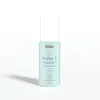What's inside
What's inside
 Key Ingredients
Key Ingredients

 Benefits
Benefits

 Concerns
Concerns

 Ingredients Side-by-side
Ingredients Side-by-side

Water
Skin ConditioningGlycerin
HumectantPolyacrylate Crosspolymer-6
Emulsion StabilisingSaccharide Isomerate
HumectantButylene Glycol
HumectantPhenoxyethanol
PreservativeCaesalpinia Spinosa Gum
Skin ConditioningAlpha-Glucan Oligosaccharide
CleansingAnthemis Nobilis Flower Oil
MaskingDisodium EDTA
Ethylhexylglycerin
Skin ConditioningCitric Acid
BufferingSodium Citrate
BufferingCinnamomum Cassia Bark
Skin ConditioningZingiber Officinale Root Extract
MaskingSanguisorba Officinalis Root Extract
CleansingNiacinamide
SmoothingTocopherol
AntioxidantGarcinia Mangostana Fruit Extract
Skin ConditioningRosa Moschata Seed Oil
EmollientVitis Vinifera Seed Oil
Emollient1,2-Hexanediol
Skin ConditioningXanthan Gum
EmulsifyingCaprylyl Glycol
EmollientGlucose
HumectantSodium Hyaluronate
HumectantChondrus Crispus Extract
Skin ConditioningHydroxypropyltrimonium Hyaluronate
Hydrolyzed Hyaluronic Acid
HumectantSodium Acetylated Hyaluronate
HumectantHyaluronic Acid
HumectantHydrolyzed Sodium Hyaluronate
Skin ConditioningSodium Hyaluronate Crosspolymer
HumectantPotassium Hyaluronate
Skin ConditioningWater, Glycerin, Polyacrylate Crosspolymer-6, Saccharide Isomerate, Butylene Glycol, Phenoxyethanol, Caesalpinia Spinosa Gum, Alpha-Glucan Oligosaccharide, Anthemis Nobilis Flower Oil, Disodium EDTA, Ethylhexylglycerin, Citric Acid, Sodium Citrate, Cinnamomum Cassia Bark, Zingiber Officinale Root Extract, Sanguisorba Officinalis Root Extract, Niacinamide, Tocopherol, Garcinia Mangostana Fruit Extract, Rosa Moschata Seed Oil, Vitis Vinifera Seed Oil, 1,2-Hexanediol, Xanthan Gum, Caprylyl Glycol, Glucose, Sodium Hyaluronate, Chondrus Crispus Extract, Hydroxypropyltrimonium Hyaluronate, Hydrolyzed Hyaluronic Acid, Sodium Acetylated Hyaluronate, Hyaluronic Acid, Hydrolyzed Sodium Hyaluronate, Sodium Hyaluronate Crosspolymer, Potassium Hyaluronate
Water
Skin ConditioningCentella Asiatica Extract
CleansingButylene Glycol
HumectantGlycerin
HumectantDimethicone
EmollientHydroxyethyl Acrylate/Sodium Acryloyldimethyl Taurate Copolymer
Emulsion Stabilising1,2-Hexanediol
Skin ConditioningCetyl Alcohol
EmollientCetearyl Olivate
Sorbitan Olivate
EmulsifyingCaprylhydroxamic Acid
Stearyl Alcohol
EmollientAllantoin
Skin ConditioningBetaine
HumectantPanthenol
Skin ConditioningPolysorbate 60
EmulsifyingXanthan Gum
EmulsifyingSorbitan Isostearate
EmulsifyingMyristyl Alcohol
EmollientMelaleuca Alternifolia Leaf Oil
AntioxidantEucalyptus Globulus Leaf Oil
PerfumingLauryl Alcohol
EmollientPantolactone
HumectantSodium Hyaluronate
HumectantWater, Centella Asiatica Extract, Butylene Glycol, Glycerin, Dimethicone, Hydroxyethyl Acrylate/Sodium Acryloyldimethyl Taurate Copolymer, 1,2-Hexanediol, Cetyl Alcohol, Cetearyl Olivate, Sorbitan Olivate, Caprylhydroxamic Acid, Stearyl Alcohol, Allantoin, Betaine, Panthenol, Polysorbate 60, Xanthan Gum, Sorbitan Isostearate, Myristyl Alcohol, Melaleuca Alternifolia Leaf Oil, Eucalyptus Globulus Leaf Oil, Lauryl Alcohol, Pantolactone, Sodium Hyaluronate
 Reviews
Reviews

Ingredients Explained
These ingredients are found in both products.
Ingredients higher up in an ingredient list are typically present in a larger amount.
1,2-Hexanediol is a synthetic liquid and another multi-functional powerhouse.
It is a:
- Humectant, drawing moisture into the skin
- Emollient, helping to soften skin
- Solvent, dispersing and stabilizing formulas
- Preservative booster, enhancing the antimicrobial activity of other preservatives
Butylene Glycol (or BG) is used within cosmetic products for a few different reasons:
Overall, Butylene Glycol is a safe and well-rounded ingredient that works well with other ingredients.
Though this ingredient works well with most skin types, some people with sensitive skin may experience a reaction such as allergic rashes, closed comedones, or itchiness.
Learn more about Butylene GlycolGlycerin is already naturally found in your skin. It helps moisturize and protect your skin.
A study from 2016 found glycerin to be more effective as a humectant than AHAs and hyaluronic acid.
As a humectant, it helps the skin stay hydrated by pulling moisture to your skin. The low molecular weight of glycerin allows it to pull moisture into the deeper layers of your skin.
Hydrated skin improves your skin barrier; Your skin barrier helps protect against irritants and bacteria.
Glycerin has also been found to have antimicrobial and antiviral properties. Due to these properties, glycerin is often used in wound and burn treatments.
In cosmetics, glycerin is usually derived from plants such as soybean or palm. However, it can also be sourced from animals, such as tallow or animal fat.
This ingredient is organic, colorless, odorless, and non-toxic.
Glycerin is the name for this ingredient in American English. British English uses Glycerol/Glycerine.
Learn more about GlycerinSodium Hyaluronate is hyaluronic acid's salt form. It is commonly derived from the sodium salt of hyaluronic acid.
Like hyaluronic acid, it is great at holding water and acts as a humectant. This makes it a great skin hydrating ingredient.
Sodium Hyaluronate is naturally occurring in our bodies and is mostly found in eye fluid and joints.
These are some other common types of Hyaluronic Acid:
Learn more about Sodium HyaluronateWater. It's the most common cosmetic ingredient of all. You'll usually see it at the top of ingredient lists, meaning that it makes up the largest part of the product.
So why is it so popular? Water most often acts as a solvent - this means that it helps dissolve other ingredients into the formulation.
You'll also recognize water as that liquid we all need to stay alive. If you see this, drink a glass of water. Stay hydrated!
Learn more about WaterXanthan gum is used as a stabilizer and thickener within cosmetic products. It helps give products a sticky, thick feeling - preventing them from being too runny.
On the technical side of things, xanthan gum is a polysaccharide - a combination consisting of multiple sugar molecules bonded together.
Xanthan gum is a pretty common and great ingredient. It is a natural, non-toxic, non-irritating ingredient that is also commonly used in food products.
Learn more about Xanthan Gum